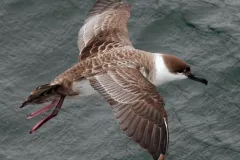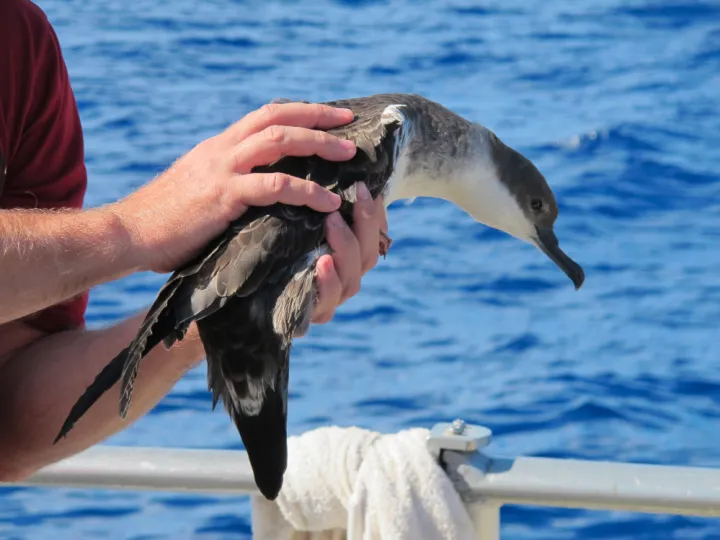12,000 Miles to Go: Migrating with Shearwaters

Oceanic birds are a rare treat to see because these birds are not casual visitors to our coastline—to see them you normally have to get on a boat. So late last spring I was amazed to find hundreds of shearwaters stranded on the beach along the Atlantic coast of Florida. Shearwaters are oceanic birds related to albatrosses that spend most of their lives at sea, normally coming to land only to breed. In talking with locals, I learned that the strandings happen when strong winds blow out of the East. Weak from their long migrations, these birds had the bad luck to encounter strong winds as they were traveling in the Gulf Stream and were pushed to shore through stormy surf.
The majority of the stranded birds were Great Shearwaters, which follow the Gulf Stream along the eastern U.S. coast to migrate between their breeding and feeding grounds. Their voyage starts in the Tristan da Cunha islands, almost exactly in-between the southernmost reaches of Argentina and South Africa, where they lay eggs in shallow burrows during the Southern Hemisphere summer. Then, in time for the Northern Hemisphere summer, the birds travel more than 6,000 miles to the cold, nutrient-rich water of the North Atlantic. Lucky shearwaters will make this tremendous round-trip voyage for over 60 years.
Shearwaters aren’t the only seabirds that undertake voyages of this caliber. Tiny Wilson’s Storm-petrels, about the size of sparrows, travel the same route, while Pomarine Jaegers and Red Phalaropes do the opposite, traveling from breeding grounds in the Arctic to the deep cold waters in the Southern Ocean. The Bermuda Petrel or ‘cahow,’ a bird so rare that it was thought to be extinct for one hundred years, has been spotted as far from its mid-Atlantic breeding island as Iceland and North Carolina. And Sooty Shearwaters transit both the Atlantic and Pacific Oceans in their entirety, looping figure-eights over tens of thousands of miles in pursuit of the richest food sources.
Unlike most landbirds, shearwaters and their relatives have olfactory capabilities that would rival a bloodhound. When you live on the open ocean, any clue as to where food might be hiding under the surface is critical. Brian Patteson and Kate Sutherland, who guide pelagic bird tours to the Gulf Stream off North Carolina, use this remarkable ability to their advantage when dealing with fast-moving Pterodroma petrels and other hard-to-find seabirds that many clients come to see. A slow drip of menhaden oil off of the side of the boat will attract shearwaters and relatives from across miles of open ocean. Typically the shearwaters stop by the boat, feed for a few moments, and then continue on their voyage.
But by the last few days of June, most of the shearwaters will have exited the Gulf Stream for the banks and shoals of New England and Atlantic Canada. Access to the birds here is easier, as the same small fish like sandlance and capelin that attract the birds also attract whales and whale watchers. On a half-day boat trip to Stellwagen Bank off of Cape Cod, no slick of menhaden oil is needed to draw in the birds; the whales do that through their boisterous feeding. Here, great shearwaters mingle with other species such as Manx shearwaters, which hunt to feed chicks that may be hundreds of miles away. As summer ends, the birds will use currents flowing south and away from the Gulf Stream to start the long trip back home.
And what of the stranded birds I saw in the spring? Unfortunately most didn’t make it, but the few great shearwaters that recovered with the help of rehabilitators throughout Florida were ready to go back to the ocean by late July. I joined Michael Brothers of the Volusia County Marine Science Center on a pelagic seabird trip that would also serve as the release party for a Great Shearwater. As we made our way out to the Gulf Stream, Michael searched for lines of Sargassum that might provide the bird with an easy food source. Floating Sargassum seaweed is filled with juvenile fish and shrimp, giving the bird easy pickings. When healthy, shearwaters can dive more than 50 feet (15 meters) beneath the surface in pursuit of fish, propelled by their webbed feet and the beating of half-folded wings, but a rehabilitated bird may not be able to dive so deep.
More than 50 miles from shore, he carried the bird to the stern of the boat and let it flutter to the surface of the water. With some luck, it will gain strength at its North Atlantic feeding grounds, return to its breeding grounds much farther south, and then repeat the journey for years to come.
Editor's Note: View a larger version of the above slideshow here.


